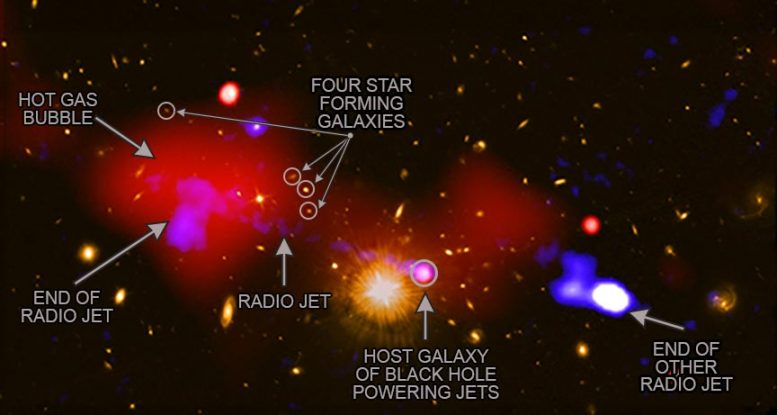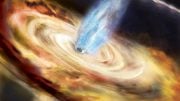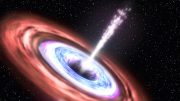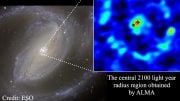
This image contains a black hole that is triggering star formation across the longest distance ever seen. As hot gas swirls around the black hole, it emits large amounts of X-rays that Chandra detects. The black hole is also the source of radio-wave emission from a jet of high-energy particles — previously detected by scientists with the VLA — that stretches about a million light years. Astronomers found that this black hole and jet are responsible for increasing the rates of star formation in newly-discovered nearby galaxies.
(Credit: X-ray: NASA/CXC/INAF/R. Gilli et al.; Radio NRAO/VLA; Optical: NASA/STScI)
- One black hole is influencing the rate of star formation in multiple galaxies and across vast distances.
- This is a rare example of “positive feedback” where a black hole is helping to spur star formation, not suppress it.
- Researchers used X-rays from Chandra, radio waves from the VLA, and optical light from ground-based telescopes to make this discovery.
- If confirmed, this result would represent the largest distance over which a black hole has boosted the birth of stars.
This image contains a black hole that is triggering star formation across the longest distance ever seen. The black hole is located in the center of a galaxy — identified in a labeled image — about 9.9 billion light-years from Earth. In this composite image, X-rays from NASA’s Chandra X-ray Observatory (red) have been combined with radio emission detected by the NSF’s Karl Jansky Very Large Array, or VLA, (blue), and an optical image from NASA’s Hubble Space Telescope (yellow).
As hot gas swirls around the black hole, it emits large amounts of X-rays that Chandra detects. The black hole is also the source of radio-wave emission from a jet of high-energy particles — previously detected by scientists with the VLA — that stretches about a million light-years. The jet is also identified in the labeled image. The end of the jet is highlighted by diffuse radio emission caused by the particles slowing down after interacting with surrounding matter. A bright source of radio emission (blue and white) on the opposite side of the black hole marks the end of a second jet of particles. This jet is not visible in the radio image.
Researchers also found a diffuse cloud of X-ray emission surrounding the end of the jet on the left. This X-ray emission is most likely from a gigantic bubble of hot gas heated by the interaction of the jet’s particles with surrounding matter. As the hot bubble expanded and swept through four neighboring galaxies it could have created a shock wave that compressed cool gas in the galaxies, causing stars to form. The authors estimate that the star formation rates are between about 100% and 400% higher than typical galaxies with similar masses and distance from Earth.
The black hole’s galaxy and the four galaxies with boosted star formation have at least three neighboring galaxies. This system of galaxies was identified using observations with the European Southern Observatory’s Very Large Telescope (VLT) and the Large Binocular Telescope (LBT). These galaxies will likely become part of a group or cluster of galaxies that has been caught early in its formation process.
Astronomers have seen many cases where a black hole affects its surroundings through “negative feedback”. This occurs when the black hole chokes off star formation because it injects sufficient energy into a galaxy’s or a galaxy cluster’s hot gas to prevent it from cooling down to make stars. In this newly discovered collection of galaxies, astronomers have found a less common example of positive feedback, where the black hole’s effects increase star formation.
The researchers used a total of six days of Chandra observing time spread out over five months. A paper describing these results has been published in the most recent issue of the journal “Astronomy and Astrophysics” and is available online. NASA’s Marshall Space Flight Center manages the Chandra program. The Smithsonian Astrophysical Observatory’s Chandra X-ray Center controls science and flight operations from Cambridge and Burlington, Massachusetts.
| Fast Facts for Positive Feedback Black Hole: | |
| Credit | X-ray: NASA/CXC/INAF/R. Gilli et al.; Radio NRAO/VLA; Optical: NASA/STScI |
| Release Date | November 26, 2019 |
| Scale | Image is about 2 arcmin (3.4 million light-years) across. |
| Category | Black Holes, Groups & Clusters of Galaxies |
| Coordinates (J2000) | RA 10h 30m 27s | Dec +05° 24´ 55″ |
| Constellation | Sextans |
| Observation Date | 10 pointings Jan 17, 2017- May 27, 2017 |
| Observation Time | 132 hours 58 min (5 days 12 hours 58 minutes) |
| Obs. ID | 18185-18187, 19926, 19987, 19994-19995, 20045-20046, 20081 |
| Instrument | ACIS |
| References | Gilli, R. et al. 2019; A&A in press. arXiv: 1909.00814 |
| Color Code | X-Ray: Red; Radio: Blue; Optical: Yellow |









Be the first to comment on "Positive Feedback Black Hole Triggers Star Formation a Million Light Years Away"